Unit 7 Food FestivalTopic 2 I’m not sure whether I can cook it well 教学设计
- 格式:doc
- 大小:116.50 KB
- 文档页数:12
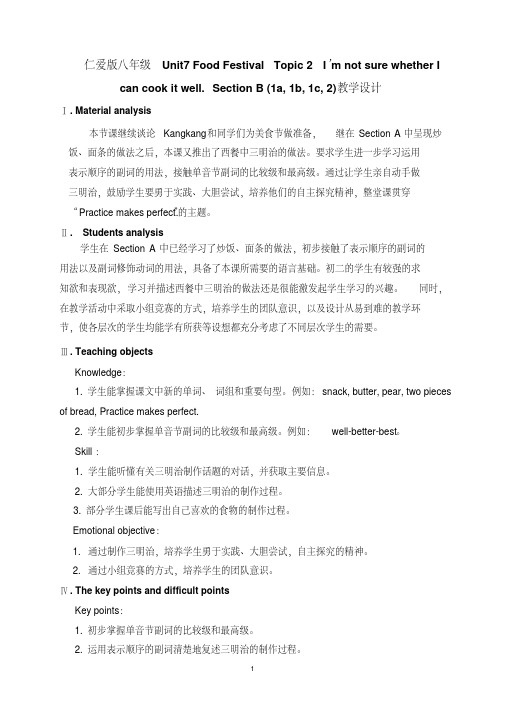
仁爱版八年级Unit7 Food Festival Topic 2 I’m not sure whether I can cook it well. Section B (1a, 1b, 1c, 2) 教学设计Ⅰ. Material analysis本节课继续谈论Kangkang和同学们为美食节做准备,继在Section A中呈现炒饭、面条的做法之后,本课又推出了西餐中三明治的做法。
要求学生进一步学习运用表示顺序的副词的用法,接触单音节副词的比较级和最高级。
通过让学生亲自动手做三明治,鼓励学生要勇于实践、大胆尝试,培养他们的自主探究精神,整堂课贯穿“Practice makes perfect.”的主题。
Ⅱ. Students analysis学生在Section A中已经学习了炒饭、面条的做法,初步接触了表示顺序的副词的用法以及副词修饰动词的用法,具备了本课所需要的语言基础。
初二的学生有较强的求知欲和表现欲,学习并描述西餐中三明治的做法还是很能激发起学生学习的兴趣。
同时,在教学活动中采取小组竞赛的方式,培养学生的团队意识,以及设计从易到难的教学环节,使各层次的学生均能学有所获等设想都充分考虑了不同层次学生的需要。
Ⅲ. Teaching objectsKnowledge:1. 学生能掌握课文中新的单词、词组和重要句型。
例如:snack, butter, pear, two pieces of bread, Practice makes perfect.2. 学生能初步掌握单音节副词的比较级和最高级。
例如:well-better-best。
Skill:1. 学生能听懂有关三明治制作话题的对话,并获取主要信息。
2. 大部分学生能使用英语描述三明治的制作过程。
3. 部分学生课后能写出自己喜欢的食物的制作过程。
Emotional objective:1.通过制作三明治,培养学生勇于实践、大胆尝试,自主探究的精神。

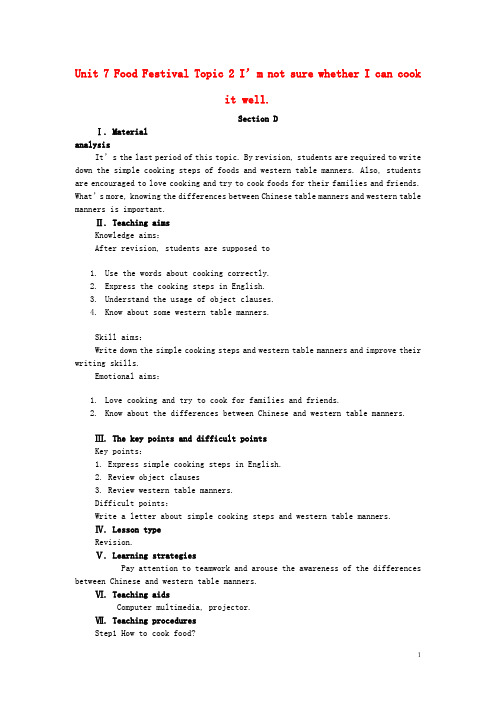
Unit 7 Food Festival Topic 2 I’m not sure whether I can cookit well.Section DⅠ. MaterialanalysisIt’s the last period of this topic. By revision, students are required to write down the simple cooking steps of foods and western table manners. Also, students are encouraged to love cooking and try to cook foods for their families and friends. What’s more, knowing the differences between Chinese table manners and western table manners is important.Ⅱ. Teaching aimsKnowledge aims:After revision, students are supposed toe the words about cooking correctly.2.Express the cooking steps in English.3.Understand the usage of object clauses.4.Know about some western table manners.Skill aims:Write down the simple cooking steps and western table manners and improve their writing skills.Emotional aims:1.Love cooking and try to cook for families and friends.2.Know about the differences between Chinese and western table manners.Ⅲ. The key points and difficult pointsKey points:1. Express simple cooking steps in English.2. Review object clauses3. Review western table manners.Difficult points:Write a letter about simple cooking steps and western table manners.Ⅳ. Lesson typeRevision.Ⅴ. Learning strategiesPay attention to teamwork and arouse the awareness of the differences between Chinese and western table manners.Ⅵ. Teaching aidsComputer multimedia, projector.Ⅶ. Teaching proceduresStep1 How to cook food?1. Greeting.2. Play a word game:Rules: Discuss and write down the words in groups.Say out the words as many as possible. (No more than 3 words.)1 word = 1 point;2 words = 2 points;3 words = 3 points3. Retell cooking steps of fried rice, noodles and a sandwich with butter, honey and a pear with given key words.Step 2 Read a letter and finish the tasksDear Helen,An American neighbor invites me to go to a dinner party tomorrow. I think that I will cook chicken soup, but I’m not sure whether I can cook it well. Could you teach me how to cook it? And you know that I don’t know about the western table manners. Do you know whether it’s polite or not to eat up the food on my plate? Can you tell me if it is polite to speak loudly at the table?I’m looking forward to hearing from you.Yours,LiHong1.Answer questions:1.Who wrote the letter?2.What’re his/her problems?3.Think about the cookers and ingredients of cooking chicken soup.2.Underline the object clauses and circle the introducers in the letter.3.Review the rules of object clauses and do some exercises.4.Pictures about western table manners.5.Suppose you are Helen, write a letter back to Li Hong.要求:a.语句通顺,句法正确,意思连贯。
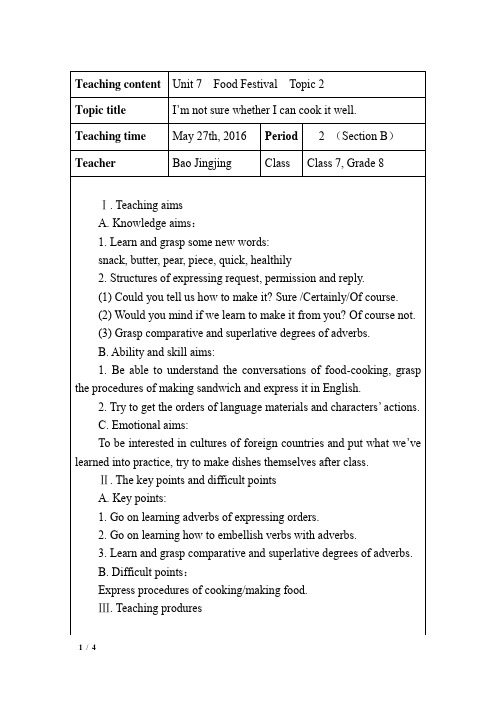
Stage 1 (3 minutes):Getting students ready for learning step Teacher activityStudent activity Purpose1.Greet to the students: Good morning, ladies and gentlemen!2. Look the screen. Who can tell me how to cook porridge/fried rice/noodles?1. Good morning,Miss Bao!2. I can tell you how to cook ...First, … Next, … Then, … After that, ... Finally, … 1. Focus attention on Miss Bao. 2. Get them ready for learning.Stage 2 (2 minutes):Revisionstep Teacher activity Student activityPurposeShow a short passage to review Section A. Ask some students to fill in the blanks.Fill in the blanks in the shortpassageto review Section A.Review vocabulary andgrammar.Remark:Stage 3 ( 15~17 minutes):Conversationstep Teacher activityStudent activityPurpose Aim Show the aims and read them.2 minutes, to be familiarwith the new words.Show pictures to learn the new words: snack, butter, and piece. Read and remember.1. Play the recording. a. First time: b. Second time: check the answers.1.Think over and finish: a. Michael’s favourite snack, ingredients for making sandwiches. b. Process of making it.3 minutes for listening and 2 minutes to check.W a r m -u pR e v i s i o nC o n v e r s a t i o n L i s t e n i n gV o c a b u l a r ystep Teacher activity Student activity Purpose1. Play the recording.2. Ask the students to practise in groups.3. Acting time.4. Comparison.1. Read after it.2. Do as the teacherasked to. 3. Show time. They can change the materials of making sandwiches. 4. Compare better and best.8~10 minutes. Help them to grasp comparativeandsuperlative degrees of adverbs, lead in next part.Remark:Stage 4 (5~8 minutes):WritingstepTeacher activityStudent activity PurposeShow the adverbs for orders again. Then some pictures.Retell the process ofmaking a sandwich. Write an article of making other food(examples).5~8 minutes. Change the dialog into a passage.Remark:Stage 5 (5minutes):Exersicestep Teacher activity Student activity PurposePart 2 on Page 65. Show the pictures and sentences. Match and practise. Try to make more sentences by themselves. 3 minutes.Deeper practice of comparative and superlative degrees Part 3 on Page 66. Show the pictures and sentences.Listen and order the sentences to form a conversation.2 minutes.Deeper practice of comparative and superlative degreesC o n v e r s a t i o n P r a c t i c i n gW r i t i n gE x e r c i s eRemark:Stage 6 (5minutes):Summary and homeworkstep Teacher activity Student activityEffect1. Summarize and givesummative assessment. 2. Homework: a. Deeper remember the vocabulary and review what we’ve learned today. b. Preview Section C, learn table manners .1. Follow together and conclude what havelearned.2. Follow the requirement.Blackboard DesignTopic 2 I’m not sure whether I can cook it well.Section BⅠ. New wordssnack, butter, pear, piece, quick, healthily Ⅱ. Grammar1. Adverbs of expressing orders:First,…First, … Next, … Then, … After that, ... Finally, … 2. Comparative and superlative degrees of adverbs. well -better -best early -earlier -earliest long -longer -longest Ⅲ. Structures Would you mind if…? Would you mind doing…? Ⅳ. SayingPractice makes perfectA s s e s s m e n t。
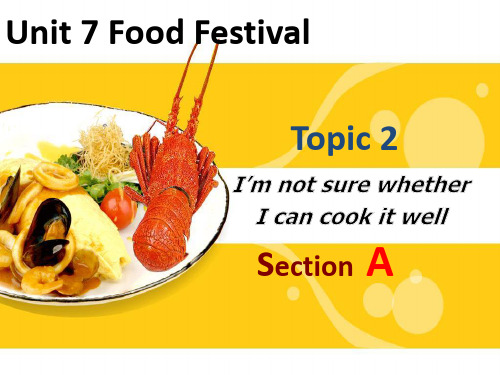
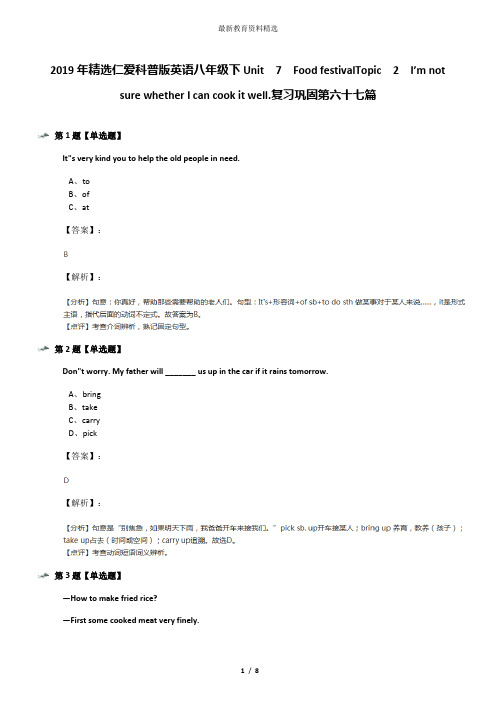
Unit7 Food FestivalTopic2 I’m not sure whether I can cook it well.Section A一、教学目标1、知识与技能①学习单词和词组:cut,oil, add, cooker, pork, ham, noodle, bowl, immediately, advantage, cheap,cut up, first…next…finally…②学习whether引导的宾语从句。
③学会表示顺序的副词的用法。
2、情感态度与价值观采用情感激励策略,鼓励学生树立信心,大胆创造机会,实现和完善自我。
同时,培养学生形成互学互助的合作意识、竞争意识及团队协作精神。
二、教学重点和难点1、从知识层面上看,这节课的重点在于让学生掌握whether引导的宾语从句;运用表示顺序的副词描述制作炒饭和面条的制作过程和方法。
2、从能力层面上看,这节课的教学重、难点在于通过教师有目的引导,培养学生在探究活动中观察、分析、比较、总结和归纳的能力,培养学生自主学习的能力。
3、从情感态度层面上看,这节课的教学重、难点在于如何鼓励学生树立信心,大胆参与,使教学的每个环节,每个活动更有实效性。
三、教学过程Step1 Warming upStep2 Competition1、Let students speak out words about food,and the group which speaks the most is the winner.2、Let students listen to 3,choose the best answers,and then check the answers.Step3 Presentation1、Ask and answer between the teacher and students.T:Do you like fried rice?Can you make fried rice?S1:Yes,I can./No,I can’t.T:If you can’t,today let’s learn how to do it.2、Let students list:words about kitchen utensils:pan,pot,cooker,bowlwords about materials of food:oil,pork,ham,onion,noodlewords and phrases about action:cut,cut up,fry,addAdverbs of manner: finely,lightly,immediately3、Let students listen to 1a and discuss how to cook fried rice to lead to the adverbs of sequence.4、Let students read 1a,find out the adverbs of manner,and pay attention to their formation and usagers. Let students circle the adverbs of sequence.Careful+ly→carefully cook... carefullyLight+ly→lightly fry... lightlyFine+ly→finely cut... finelySlow+ly→slowly add... slowlyFirst…,next…,finally…Step4 Consolidation1、Let students read 1a again,find out some language points.Make sth. for sb. try to do sth.Would you like me to help you?Well done.But I’m sure whether I can cook it well.2、Let students listen to the tape and follow it.3、Let students finish 1b according to 1a.Check the answers.4、Encourage students to retell 1a according to 1b.Step5 Practice1、Let students read 2a and fill in the blanks with the proper forms of the given words.Check the answers together.2、Let students use the information in 2a to finish 2b.Check the answers.3、Encourage students to retell 2a according to 2b.Step6 Project1、Work in groups①Let students work in groups to discuss how to cook a certain kind of food.②Report the cooking procedure of this kind of food to the class.2、Let students write a passage about the cooking procedure of their favorite food with proper adverbs of sequence and manner.Step7 Homework1、Recite 1a.2、Finish the exercises in WB.3、Preview SectionB板书设计Unit7 Topic2 SectionA.1.Careful+ly→carefully cook... carefully2.Light+ly→lightly fry... lightly3.Fine+ly→finely cut... finely4.Slow+ly→slowly add... slowly5.First…,next…,then…,after that…finally…6.But I’m not sure whether I can cook it well.Would you like me to help you?Well done.。
Unit 7 Food Festival Topic 2 I’m not sure whether I cancook it well Section ALesson Objective:By the end of this lesson, students will be able to:1. Analyze a conversation about cooking skills and confidence.2. Identify and use modal verbs to express ability and possibility.3. Describe their own cooking abilities and experiences.4. Engage in a roleplay activity to practice expressing doubt and certainty.5. Discuss the importance of practice and patience in learning to cook. Materials:1. Textbook containing Section A of Unit 7, Topic2.2. Whiteboard and markers for notetaking and illustrations.3. Handouts with a dialogue that uses modal verbs in context.4. Realia such as cooking utensils or ingredients for an interactive activity.5. Multimedia resources like videos or images depicting different cooking skills.Procedures:I. Warmup Activity (5 minutes)Begin by asking students if they enjoy cooking and if they feel confident in their cooking skills. This will activate their prior knowledge on the topic and encourage them to share their experiences.II. Vocabulary Preview (10 minutes)Review key vocabulary related to cooking methods, utensils, and ingredients using flashcards or a word wall. Encourage students to use these words in sentences as you introduce them.III. Reading and prehension (15 minutes)Instruct students to read Section A of the textbook while focusing on the conversation between two friends discussing their cooking abilities. After reading, ask several prehension questions to ensure understanding of the text.IV. Grammar Focus (10 minutes)Explain the usage of modal verbs (can, could, may, might, will, would) for expressing ability and possibility. Provide examples from the text and create sentences together as a class to reinforce understanding.V. Pair Work (10 minutes)Have students work in pairs to practice a similar conversation about their own cooking abilities. They should use the modal verbs from the previous activity to express doubt and certainty in their cooking skills. VI. RolePlay Activity (20 minutes)Divide the class into small groups and assign each group a scenario where they have to discuss and plan a meal together, considering their varying levels of cooking skill and confidence. After planning, have each group present their meal plan and the roles they will play in preparing it.VII. Whole Class Discussion (15 minutes)Discuss the importance of practice and patience in improving cooking skills, drawing from the experiences shared during the roleplay. Ask students to think about how their attitudes towards learning to cook might affect their success.VIII. Assessment (5 minutes)Assess student understanding through an exit ticket where they write down one sentence using a modal verb to describe their confidence in a particular cooking task.IX. HomeworkAssign homework where students write a short paragraph about a dish they would like to learn to cook and the steps they would take to achieve this, focusing on the language of possibility and ability. Differentiation:Support students who may need help with the content or language by providing additional practice materials or a list of useful phrases for the pair work and roleplay activities. For advanced learners, consider extending the roleplay to include a wider range of scenarios or more plex dishes.Conclusion:This lesson focuses on practical language used in discussions about cooking and personal abilities. Students are encouraged to applygrammar concepts in authentic contexts while gaining confidence in expressing their capabilities and intentions. The inclusion of interactive activities promotes engagement and emphasizes the value of perseverance in developing new skills.。
仁爱版英语八年级下册Unit 7 Food FestivalTopic 2 I`m not sure whether I can cook it well.Section A一、教材分析本课是初中仁爱版八年级上册。
Topic 2 I`m not sure whether I can cook it well. Section A该部分主要谈论康康想要为即将开始的美食节学做炒饭,进而引出谈论做烹饪步骤的表达,描述方式的副词。
本课的语法项目:whether引导的宾语从句以及复习that引导的宾语从句,此外也包含了请求的问句Would you like…? 夸奖别人Well done!以及修饰动词的副词finely,lightly, slowly,carefully,做事情的步骤表达first,next,after that ,finally等。
八年级的学生,经过近两年的英语学习,大部分的学生已具有一定的语法和词汇量,对于新的句型,大多数的学生需要在教师的指导与提示下进行操练。
少部分学生,没有养成良好的学习习惯,英语基础差,对英语有畏惧感,有为难情绪;针对这种情况,我把学生进行分组,采用小组合作学习。
二、教学目标1) 能拼读:finely, lightly, oil, pan, add, fry, ingredient, pot, cooker, pork, bowl , cut up, a bowl of2) 学会句型:①请求的问句:Would you like…?②做事情的步骤表达:First … Second … Next … Then … After that … Finally …③宾语从句—I`m not sure whether I can cook do it well三、教学重点、难点分析1.教学重点:(1)掌握句型:—Would you like me to help you ?;—Yes ,please. It`s very nice of you .—I`m not sure whether I can cook do it well.(2)学习whether引导的宾语从。
Unit 7 Food Festival
Topic 2 I’m not sure whether I can cook it well.
教学内容分析及课时分配建议:
本单元第二个话题在复习上个话题的基础上,引入新的内容包括步骤的表达,描述方式的副词,做饭材料、做饭所用厨具以及吃饭所用的餐具等词汇。
主要句型有提供帮助Would you like me to help you?赞美和鼓励Well done!请求得到允许Would you mind if I…?就餐用语help yourself to some…以及提醒和警告remember (not) to …语法包括whether/if引导的宾语从句;副词的比较级和最高级。
本话题语音部分的内容包括/t∫/和/d E/的区分以及升降调的区分。
此外,本话题贴近学生生活实际,从教学生做各种食物到不同国家的餐桌礼仪和饮食文化,学生不仅可以学到语言知识还可以培养生活技能,拓展文化意识。
第一课时:Section A- 1a, 1b, 1c ,2a, 2b
第二课时:Section B-1a, 1b, 1c, 2 Section A-3a, 3b
第三课时:Section C-1a,1b,1c, 4
第四课时:Section C-2, 3 Section B-3, 4a, 4b
第五课时:Section D-Grammar and Functions, 1, 2, 3, Project
第四课时(Section C-2, 3 Section B-3,4a, 4b)
教学设计思路:
本节课主要活动为Section C -2,3。
本节课的课型为语法语音课。
在复习环节里按照上一课的作业布置,要求学生边表演西方餐桌礼仪边讲解。
语法环节从讨论中国的餐桌礼仪入手,首先学习本课出现的新词汇,并在师生讨论中运用目标语言——宾语从句,之后导入到对其他国家餐桌礼仪的讨论。
学习语法的过程中,教师鼓励学生自己发现和总结语法规律,并根据学生理解和掌握的程度加以引导、点拨和补充。
比如在本课中,教师要求学生自己找到宾语从句的关系词,自己发现一般疑问句和宾语从句在语序方面的不同。
之后以练习的方式加以巩固。
本课将Section B-3设计成Reading and speaking的活动。
原因是学生通过阅读就可以完成排序的任务,而且认真的阅读比听更深刻地理解对话的意义。
之后,通过听录音和模仿练习语音语调,同时导入Section B-4a、4b。
Ⅰ. Teaching aims
1.Knowledge aims:
(1)学习并掌握新词汇
spoon, chopstick, finger, elbow, slurp, noisily
(2)继续学习宾语从句
I want to know whether/if it is polite to point with chopsticks at people in China. (3)了解不同国家的餐桌礼仪。
(4)掌握辅音音素/t∫/和/d E/。
(5)学会朗读句子时正确处理语调和停顿。
2. Skill aims:
(1)能利用宾语从句讨论不同国家的餐桌礼仪。
(2)能区分辅音音素/t∫/和/d E/, 并能正确拼读单词。
(3)学生能在朗读句子时正确处理语调和停顿。
3. Emotional aims:
乐于接触和了解外国风俗文化,从而更好地为弘扬中国文化服务。
4. Culture awareness:
了解各国饮食习惯和餐桌礼仪,做个有国际视野的人。
Ⅱ. The key points and difficult points
1. Key points:
(1)继续学习whether/if引导的宾语从句。
(2)了解不同国家的餐桌礼仪。
2. Difficult points:
利用whether/ if 引导的宾语从句谈论不同国家的餐桌礼仪。
Ⅲ. Learning strategies
1. 了解不同国家的餐桌礼仪有助于更好地进行跨文化交流。
2. 在学校的过程中,善于观察,勤于思考。
探究和发现语言规律。
Ⅳ. Teaching aids
多媒体课件/图片
Ⅴ. Teaching procedures
spoon chopsticks
T:Do you think whether it is polite
T: Do you know what means?
VI . Blackboard design。